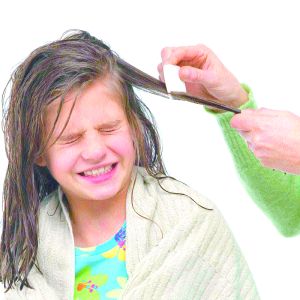A few times each year I will receive phone calls from parents who are in a panic, because they either have a child with head lice or because someone in their child’s class has head lice. Sometimes I will receive calls asking if they should pull their child out of school, not because their child has head lice, but to prevent them from getting it.
Some schools demand that parents pick-up their children right away once diagnosed with lice, or state that kids should stay home for at least 2 days after treatment. So, why are there so many questions, concerns and/or misconceptions? Is your scalp getting itchy just reading about this topic?
I am hoping this blog article will provide parents, and schools with all the data that we have at our disposal to take away any myths or misconceptions. And I hope this in turn will prevent potential outbreaks of massive hysteria amongst parents, and school staff alike.
I will use several references throughout this article. If you wish to use this blog article to show your school or other parents what current recommendations regarding head lice are, I would urge you to print the information from the different references I provide, rather than the actual blog.
What are head lice?
Head lice are wingless, 2 mm to 4 mm long (adult louse), six-legged, blood-sucking insects that live on the scalp of humans. Infested children usually carry fewer than 20 mature head lice (more commonly, less than 10 head lice), each of which, if untreated, live for three to four weeks. Head lice stay close to the scalp for food, warmth, shelter and moisture. The head louse feeds every 3 h to 6 h by sucking blood and simultaneously injecting saliva. After mating, the adult female louse can produce five to six eggs per day for 30 days, each in a shell (a nit) that is ‘glued’ to the hair shaft near the scalp. The eggs hatch nine to 10 days later into nymphs that molt several times over the next nine to 15 days to become adult head lice. The hatched empty eggshells (nits) remain on the hair, but are not a source of reinfestation. Nymphs and adult head lice can survive for up to three days away from the human host. While eggs can survive away from the host for up to three days, they require the higher temperature found near the scalp to hatch.
The classic symptom is itchiness to the scalp area leading to subsequent scratching.
Headlice do NOT spread disease.
Unlike body lice, head lice are not a health hazard, a sign of poor hygiene or a vector for disease, but are more a societal issue.
How are head lice transferred?
Head lice are spread mainly through direct head-to-head (hair-to-hair) contact. Lice do not hop or fly, but can crawl at a rapid rate (23 cm/min under natural conditions). Pets are not vectors for human head lice.
How to treat head lice?
There are special “Headlice” shampoos available. There are topical insecticides that have been most commonly used. Some contain permethrin 1% (eg “Nix” shampoo). If one is allergic to ragweeds or chrysanthemums one should not use this. There are other non-insecticide shampoos on the market in North-America that do not contain permethrin (one example is “Resultz”).
Apply the product on dry hair, using enough to wet the hair. Make sure to follow the directions on the bottle, and leave in for 10 min. Then wash hair out. Use the special lice comb to lockout any nits that are left. After 48 hours, check again for any live lice. If there are, use the special shampoo again. Check again after 7-10 days and repeat treatment.
Bedding, clothes, hats, stuffed toys etc. should be washed in hot cycle and then put in dryer in the hottest cycle. Clothes that cannot go in the dryer, can be drycleaned or sealed in plastic bag for 2 weeks. Combs, hairbrushes etc should be soaked in hot water with soap for 1 hour. Kids with long hair could have their hair pulled back while in school in order to minimize hair-to-hair contact.
Information for schools
The American Academy of Pediatrics, Canadian Pediatric Society and Centre for Disease Control all agree on return to school policy as well as whether a child should be sent home. As the lice have likely been in the hair for past 3-4 weeks prior to noticing it, there is no reason to send the child home earlier than at end of the day. Schools should provide a letter to all parents explaining someone in school has been found to have headlice, and to make sure to check their own children for lice. If lice are found, treat them. A child can be sent back to school as soon as he/she is treated (so if treated the evening before can go to school next day). Finding nits in hair does not equal “live lice”. In the past some schools in the U.S. tried a “No nits policy”, however this policy had no scientific basis. For an example of information that a local/provincial health authority distributes in school, check this link for Alberta Health Services. Please check your local health authority for more information as they might use a variation of this information.
Again, everyone should bear in mind that although a nuisance when it comes to causing itchiness and having to wash bed sheets, pillow cases etc, head lice do NOT spread disease.
Bottomline, Dr Raffi’s tips on Headlice:
1. Headlice do NOT spread disease
2. Treat with special shampoos, recheck after 48 hrs and again after 7-10 days
3. Once treated, a child can return to school
4. Useful websites are: AAP, CPS, CDC








 I am borrowing this slogan from an advertising campaign in which we are trying to educate the public that most infections are caused by viruses and not bacteria. The distinction is important, since antibiotics only work against bacterial infections. Most infections however, are caused by bugs known as “viruses” and these are the diseases that we need to fight off ourselves. We can use medicines for support, but not to “cure” infections caused by viruses.
I am borrowing this slogan from an advertising campaign in which we are trying to educate the public that most infections are caused by viruses and not bacteria. The distinction is important, since antibiotics only work against bacterial infections. Most infections however, are caused by bugs known as “viruses” and these are the diseases that we need to fight off ourselves. We can use medicines for support, but not to “cure” infections caused by viruses.